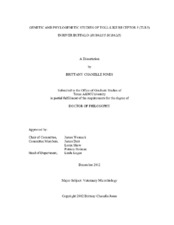| dc.contributor.advisor | Womack, James E | |
| dc.creator | Jones, Brittany | |
| dc.date.accessioned | 2013-03-14T16:13:11Z | |
| dc.date.available | 2014-12-12T07:18:55Z | |
| dc.date.created | 2012-12 | |
| dc.date.issued | 2012-08-21 | |
| dc.date.submitted | December 2012 | |
| dc.identifier.uri | https://hdl.handle.net/1969.1/148100 | |
| dc.description.abstract | River buffalo are economically important to many countries and only recently has their genome been explored for the purpose of mapping genetic variation in traits of economic and biologic interest. The purpose of this research is to characterize the genetic and evolutionary profile of Toll-like receptor 5 (TLR5), which mediates the mammalian innate immune response to bacterial flagellin.
This study is comprised of three parts: 1) generating a radiation hybrid (RH) map of river buffalo chromosome 5 (BBU5) where the TLR5 gene is located and building a comparative map with homologous cattle chromosomes; 2) conducting a single-nucleotide polymorphism (SNP) survey of the TLR5 gene to reveal variation within river buffalo and other species; and 3) performing an evolutionary study by inferring phylogenetic trees of TLR5 across multiple taxa and determining the possible evolutionary constraints within the TLR5 coding region.
River buffalo chromosome 5 is a bi-armed chromosome with arms corresponding to cattle chromosomes 16 and 29. A BBU5 RH map was developed using the previously published river buffalo RH mapping panel and cattle-derived markers. The RH map developed in this study became an integral part of the first river buffalo whole genome RH map.
Genetic variation of the TLR5 gene was evaluated in a small domestic herd of river buffalo. Sequencing of the TLR5 coding region and partial associated 5'- and 3'-untranslated regions yielded 16 novel SNPs. Six SNPs were identified as non-synonymous with one predicted to potentially code for a functionally altered product.
For the evolutionary study of the TLR5 coding region, phylogenetic trees were inferred based on TLR5 variation across multiple orders and another for artiodactyla. Species that are closely related to river buffalo appear to have undergone negative selection in TLR5 while those that diverged from river buffalo earlier may be retaining alleles that river buffalo are removing from the population.
In conclusion, putative chromosomal rearrangements were identified between river buffalo and cattle, the variation that was uncovered in the TLR5 coding region could potentially lead to differential immunity across species, and there appears be some evolutionary flexibility in the DNA sequence of the TLR5 coding region. | en |
| dc.format.mimetype | application/pdf | |
| dc.subject | radiation hybrid (RH) mapping | en |
| dc.subject | phylogenetics | en |
| dc.subject | single-nucleotide polymorphism (SNP) | en |
| dc.subject | toll-like receptor 5 (TLR5) | en |
| dc.subject | innate immunity | en |
| dc.subject | river buffalo | en |
| dc.title | Genetic and Phylogenetic Studies of Toll-Like Receptor 5 (TLR5) in River Buffalo (Bubalus Bubalis) | en |
| dc.type | Thesis | en |
| thesis.degree.department | Veterinary Pathobiology | en |
| thesis.degree.discipline | Veterinary Microbiology | en |
| thesis.degree.grantor | Texas A&M University | en |
| thesis.degree.name | Doctor of Philosophy | en |
| thesis.degree.level | Doctoral | en |
| dc.contributor.committeeMember | Derr, James | |
| dc.contributor.committeeMember | Skow, Loren | |
| dc.contributor.committeeMember | Holman, Patricia | |
| dc.type.material | text | en |
| dc.date.updated | 2013-03-14T16:13:11Z | |
| local.embargo.terms | 2014-12-01 | |


